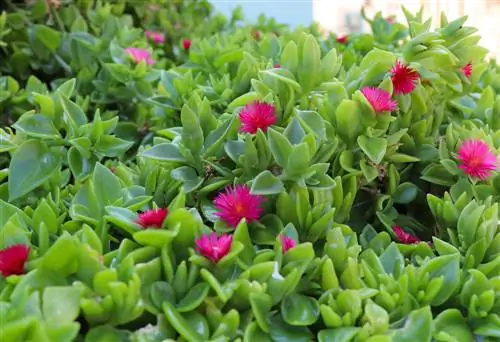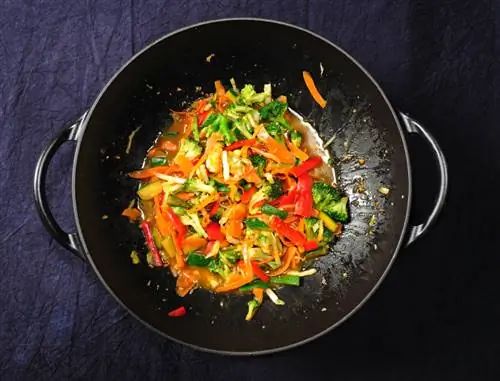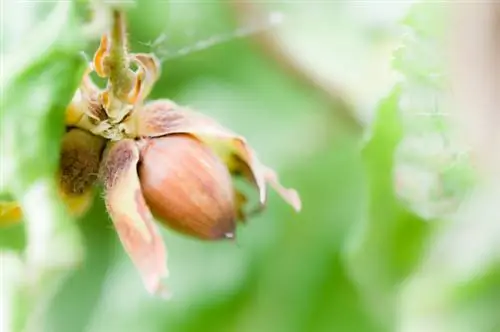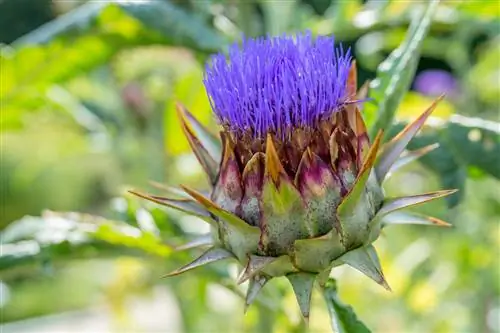- Author admin [email protected].
- Public 2023-12-16 16:46.
- Last modified 2025-01-23 11:22.
Read the commented ice herb profile here for interesting facts about growth, leaves, flowers and use. Lots of tips on planting, care and a delicious ice herb recipe.
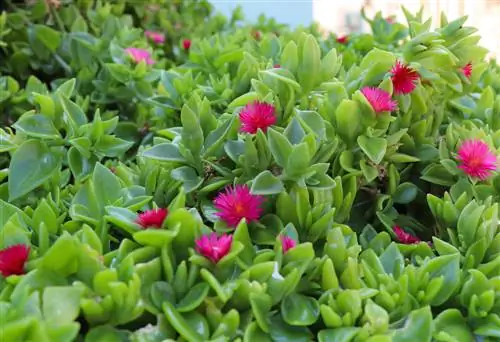
What are the growing and care conditions for iceweed?
Icewort (Mesembryanthemum crystallinum, Aptenia cordifolia) is a creeping, succulent perennial from the ice plant family. It is sensitive to frost and ideal as an ornamental plant, vegetable or salad. Ice herb requires a sunny location, loamy-sandy, well-drained soil and sparing watering.
Profile
- Scientific name: Mesembryanthemum crystallinum, Aptenia cordifolia
- Genera: Mesembryanthemum and Aptenia
- Family: Ice Plants (Aizoaceae)
- Origin: South Africa, Mediterranean region, Southern Europe
- Growth type: short-lived or perennial succulent
- Growth habit: creeping, lying down
- Growth height: 10 cm to 25 cm
- Growth width: 30 cm to 100 cm
- Leaves: succulent, glassy papillae
- Flowers: radial
- Fruits: capsule fruits
- Winter hardiness: sensitive to frost
- Use: ornamental plant, salad, vegetable
Growth
Icewort is a creeping, succulent perennial from the ice plant family (Aizoaceae). Their occurrence extends across South Africa, the Mediterranean, the Azores and Canary Islands as well as other regions in temperate, warm climates. Here iceweed thrives primarily in s alt marshes and on rocky and sandy coasts. The natural beauty owes its name to glassy leaf papillae that are reminiscent of dew drops and ice crystals. Key growth data worth knowing in brief:
- Growth habit: creeping, mat-forming with richly branched, prostrate, herbaceous shoots and star-shaped flowers in the leaf axils.
- Growth type: evergreen perennial, annual to biennial or perennial depending on the species, but not hardy.
- Growth height: 10 cm to 25 cm (during flowering).
- Growth width: depending on the species 30 cm to 100 cm.
- Gardeningly interesting properties: easy to care for, sensitive to frost, tolerates cutting, leaves and flowers suitable for consumption.
leaves
As a trendy ornamental plant, ice herb impresses with its decorative, mysteriously glittering leaves. Even under the hot summer sun, dew drops or ice crystals appear to wet the surface of the leaves. The following applies to the appetizing, crunchy leaves: “Eating is permitted”. Hobby gardeners with family gardens, salad and vegetable gardens greatly appreciate this advantage. The pretty foliage can be recognized by these features and properties:
- Leaf shape: depending on the species, egg-shaped to spatulate or heart-shaped, wavy or smooth leaf edge.
- Leaf size: 2 cm to 20 cm.
- Leaf color: evergreen, blue-green to dark green
- Texture: juicy-succulent, covered with fine, glassy, wart-like papillae.
- Leaf properties: edible
- Taste: spicy, s alty
The fleshy ice herb leaves owe their slightly s alty, spicy taste to a high content of mineral s alts.
Flowers
In spring and summer, beautiful flowers accompany the sparkling foliage. That's why the ice plant is also called ice flower. Important facts about iceweed flowers in a nutshell:
- Flower shape: circular, radiating as a single flower or inflorescence with 3 to 5 individual flowers.
- Single flower: stalked or sessile, 5 sepals, 20 to 80 narrow, filamentous petals, 30 to 50 stamens.
- Flower size: 8 mm to 20 mm in diameter.
- Flower color: depending on the species white, pink-flowering or pink to purple-red.
- Flowering period: February to July or June to October.
- Special feature: edible
In late summer and autumn, icewort bears pretty capsule fruits, covered with glassy mini papillae. Ripe fruits open and release numerous, rough seeds for self-sowing.
Iceweed species
The ice plant family provides hobby gardeners with these two beautiful species of ice weed for creative garden design:
| Iceweed species | Ice Flower | Heart-leaved Aptenia |
|---|---|---|
| Botanical name | Mesembryanthemum crystallinum | Aptenia cordifolia |
| Synonyms | Crystal Ice Plant, Soda Plant | Heart-leaved ice plant |
| Growth type | one- and two-year-old succulents | perennial succulent |
| Growth habit | crawling | lying down |
| Growth width | 70 cm to 100 cm | 20 cm to 30 cm |
| Flowering time | February to July | May to October |
| Flower color | white to pink | pink to purple |
| Leaf shape | oval to spatula-shaped | heart-shaped |
In France, iceweed was previously grown to make soda. The perennial is still known there today as a soda plant.
Usage
With its special growth properties, the ice flower is recommended for a variety of uses. Get inspired by these tips and ideas:
- Ornamental plant: beautiful ground cover in the rock garden and gravel bed, on the dry stone wall and in wall joints.
- Balcony greening: picturesque hanging plant in the balcony box, chic underplanting of privacy shrubs in the large pot.
- Herb bed: decorative component for the Mediterranean zone in the herb spiral, worth seeing in the pot on the sunny herb staircase.
- Vegetable garden: tasty salad and vegetable plant with decorative effect.
Planting iceweed
There are two options to choose from for planting. Growing on the windowsill is inexpensive and effortless. From May you can buy ready-to-plant ice herb in a tree nursery or garden center. Where and how to sow and skillfully plant an ice flower can be found here:
Sowing
The time window for sowing under glass opens in April. How to do it right:
- Fill the seed tray or growing pot with coconut soil and moisten it.
- Mix very fine seeds with bird sand and sow thinly.
- Do not sieve over the light germinator or 0.5 cm high and press it down.
- Germinate in a bright window seat at 20° Celsius.
Location, soil, substrate
These are the optimal conditions for frost-sensitive iceweed in the garden and on the balcony:
- Sunny, warm location.
- In open fields and gardens: in gravelly, loamy-sandy, well-drained soil, dry to moderately dry, poor.
- On the balcony and terrace: full sun to shade, protected from rain and wind.
Succulent soil and a mixture of peat-free potting soil, sand, coconut fibers and expanded clay are suitable as substrates for pots, tubs and balcony boxes. It is important to note that there is a low proportion of nutrients.
Planting Tips
The outdoor season for pre-grown and purchased ice herb begins in May. It's worth taking a look at these planting tips for beds and balconies:
- The planting hole in the bed soil and substrate is twice as large as the root ball.
- A layer of sand on the bottom of the pit allows water to seep away more quickly.
- Drainage made of expanded clay on the bottom of the pot and balcony box prevents waterlogging.
- Plant iceweed as deep as before in the nursery pot or purchase container.
- Press the soil and substrate down for a good soil seal and water.
A 2-week hardening phase in a partially shaded location protects the fleshy leaves from sunburn.
Excursus
Iceweed recipe idea
The spicy, fleshy ice herb leaves are ideal for a crisp salad. To make a delicate dressing, mix these ingredients together: 1 tbsp crème fraîche, 1 tbsp virgin olive oil, 1 tsp white wine vinegar, 1 tbsp orange juice (freshly squeezed), 1 finely chopped spring onion, 1 pinch of s alt. Shortly before serving, fold the washed, patted dry ice herb into the dressing in bite-sized pieces. The pink flowers serve as an appetizing decoration and are also suitable for consumption.
Care for iceweed
Caring for iceweed is easy. Two aspects require special attention for he althy, vital growth and tasty enjoyment. All other care measures follow this. It's worth taking a look at these care tips:
- Important: Pull weeds several times a week outdoors and in pots.
- Important: Cultivate ice herb as an annual or overwinter in a bright, frost-free place at a cool 5° to 8° Celsius.
- Water sparingly when the soil or potting substrate is noticeably dry.
- Fertilise lettuce organically from April to September with compost in the bed and liquid herb fertilizer on the balcony.
Greedy snails are after the juicy ice herb leaves. A traveling barrier made of sawdust or grit keeps the pests at a distance.
Propagate iceweed
Icewort responds particularly well to vegetative propagation through cuttings. Every season, cut off a few leaves with a sharp knife. A leaf cutting in a glass of soft water will root within a few days. Alternatively, stick two-thirds of the succulent leaves into moist coconut soil to take root.
Popular varieties
In addition to the two pure ice herb species, these varieties can be discovered in the plant and seed trade:
- Variegata: Heart-leaf icewort (Aptenia cordifolia) with green-white variegated, juicy leaves and magenta-pink flowers.
- Ficoïde Glaciale: French, biennial Iceweed variety for use as icedrop salad or steamed vegetables.
- S alty Ice Flower: Seed variety from Fesja with white starry flowers from May to October.
FAQ
Do you have a recipe for ice herb vegetables to cook?
In grandmother's cookbook we discovered a simple ice herb recipe for you with these ingredients: 500 grams of selected ice herb leaves, 50 grams of good butter, 2 tablespoons of flour, 1 small onion, a little s alt, pepper, nutmeg and parsley. The ice herb is briefly steamed and chopped. The finely chopped onion is fried in butter in the saucepan. Now add ice herb and the flour mixed with water. Cook the vegetables well, stirring repeatedly. Last but not least, season the ice herb vegetables to your own taste.
Are iceweed seeds dark or light germinators?
Iceweed seeds are among the light germinators. For this reason, you should only sow the seeds thinly and not cover them. To ensure a good soil seal, press the seeds with a spoon or wooden board. By mixing the tiny seeds with fine sand or bird sand before sowing, you can spread the seeds evenly.
Where can you buy ice herb?
In Central Europe, ice herb is a rarity and is rarely grown commercially. For this reason, suppliers of ready-to-plant young plants are few and far between. With a little luck you will find what you are looking for in May and June at Dehner, Floragard or Horstmann Nursery. Sources for purchasing ice weed seeds are Noah's Ark, Rühlemann's Herbal and Fragrant Plants and Jelitto Perennial Seeds.
When and how can you harvest ice cabbage lettuce?
The best time to harvest ice weed is shortly before consumption. Then the succulent leaves come to the table crisp and fresh and develop a great spicy-s alty aroma. Either cut off entire shoots or individual leaves with a sharp, disinfected knife. The plant then sprouts again.
Can icewort be used as a medicinal plant?
Iceweed does not contain any essential oils, but it does contain a high content of mineral s alts, betanin, fruit and amino acids. For this reason, the ice plant is said to have an astringent effect. In South Africa, ice herb is used as a medicinal plant for kidney disease, liver problems, and stomach and intestinal problems. Furthermore, the cooling juice of the fleshy leaves is dripped onto insect bites to relieve itching and prevent inflammation.

